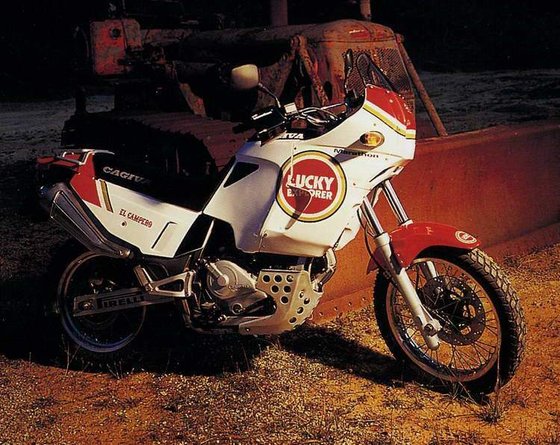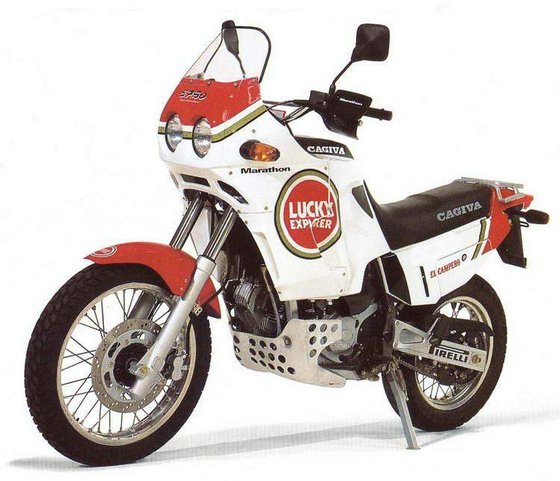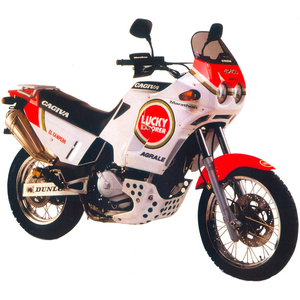Cagiva Elefant 750 [1994–1997]: A Roaming Retrospective on the Italian Trailblazer

Introduction: The Elephant in the Room
The Cagiva Elefant 750 isn’t a motorcycle that tiptoes into a room—it thunders in. Built during an era when "adventure bike" still meant rugged capability over luxury touring, the Elefant 750 (1994–1997) straddles the line between raw endurance machine and charismatic Italian roadster. With its Ducati-sourced V-twin heart and a chassis designed to shrug off both cobblestones and corrugated trails, this bike remains a fascinating study in contrasts. Let’s saddle up and explore why this underrated Italian adventurer still commands respect—and occasional sideways glances—from riders today.
Riding Experience: Where Personality Meets Pavement
The Pulse of the Desmo V-Twin
At the core of the Elefant 750 beats a 748cc, air-cooled, 90° L-twin engine—a direct descendant of Ducati’s 750SS. With desmodromic valves ensuring precise actuation, this powerplant delivers 60 HP at 6,500 RPM and a torque curve peaking at 63–64 Nm (47 lb-ft) around 5,500 RPM. On paper, these numbers seem modest, but the reality is anything but.
Twist the throttle, and the Elefant awakens with a gruff, mechanical bark. The engine thrives on revs, pulling eagerly from 4,000 RPM up to its 9,000 RPM redline. Unlike its torquier 900cc sibling, the 750 demands a more engaged riding style, rewarding those who work the 5-speed gearbox. Cruising at 130 km/h (81 mph) feels effortless, though the absence of a sixth gear means vibrations creep in during prolonged highway runs.
The hydraulic clutch is surprisingly light for a ’90s Ducati-derived setup, avoiding the infamous "on/off" grabiness of older Italian twins. Combined with a well-spaced gearbox, it makes urban commuting less of a wrist workout than you’d expect from a bike tipping the scales at 185–188 kg (407–414 lbs).
Handling: Graceful Giant or Clumsy Pachyderm?
Don’t let the Elefant’s towering stance fool you. With a seat height of 835 mm (32.9 in), it’s undeniably tall, but the narrow seat profile and low-slung V-twin keep the center of gravity manageable. Swing a leg over, and you’re greeted by wide, cross-braced handlebars that offer leverage reminiscent of a dirt bike—a trait that pays dividends on winding roads.
On asphalt, the Elefant feels improbably nimble for its size. The 45mm telescopic forks and Soft-Damp monoshock (with rising-rate linkage) are tuned for compliance rather than track-day sharpness, absorbing bumps while maintaining composure through sweeping corners. The 21-inch front wheel (100/90-19 tire) and 17-inch rear (140/80-17) strike a balance between stability and agility, though the chassis’ 1,560mm wheelbase ensures it never feels twitchy.
Off-road, the Elefant’s limitations emerge. While the bash plate and long-travel suspension (210mm front, 225mm rear) suggest trail prowess, the weight distribution and street-biased tires make it more at home on gravel fire roads than single-track mud baths. Still, for riders seeking a "gentleman’s adventurer," it’s capable enough to venture beyond the pavement.
Braking: A Call for Aftermarket Upgrades
Here lies the Elefant’s Achilles’ heel. The single 296mm front disc with a twin-piston Nissin caliper requires a firm squeeze to deliver adequate stopping power. Initial bite is soft, and lever travel is excessive by modern standards. Under heavy braking, the softly sprung forks dive noticeably, though the rear 240mm disc performs admirably. For spirited riding, upgrading to sintered pads and steel-braided lines (available at MOTOPARTS.store) is highly recommended.
Design & Build: Function Over Flair, But Not Without Charm
Chassis & Aesthetics
The Elefant’s trellis frame—a black-painted steel cradle—exudes industrial robustness. Paired with a box-section aluminum swingarm, it’s a design that prioritizes durability over elegance. The 24-liter fuel tank (6.3 US gal) dominates the silhouette, flanked by angular bodywork that screams ’90s utilitarian chic.
Early models (1994–95) featured a polarizing blue/yellow/red livery, while the "Lucky Explorer" edition swapped in a red/white scheme that aged far more gracefully. Fit and finish vary; some components (like the side stand) feel overbuilt, while others (notably the switchgear) betray Cagiva’s budget constraints.
Ergonomics: Commanding Yet Comfortable
The upright riding position is a masterclass in all-day comfort. The seat, though narrow, offers sufficient padding for multi-hour stints, and the windscreen—minimal by today’s standards—does enough to deflect chest-level turbulence. Mirrors mounted at shoulder height provide an unobstructed rear view, a rarity in the adventure segment.
Competition: How the Elefant Stacked Against the ’90s Heavyweights
Honda Africa Twin (XRV650/750)
Honda’s Africa Twin was the Elefant’s archrival, boasting legendary reliability and a smoother, liquid-cooled V-twin. However, the Honda’s 228 kg (503 lb) wet weight made it feel portly compared to the Cagiva’s leaner 185 kg (407 lb) dry figure. The Elefant’s desmo engine also delivered a rawer, more engaging character—perfect for riders craving personality over polish.
Yamaha Super Ténéré (XTZ750)
Yamaha’s parallel-twin Super Ténéré countered with a bulletproof engine and superior off-road chops. Yet its 30mm-higher seat and agricultural power delivery left road-focused riders cold. The Elefant’s sharper handling and Ducati-derived soundtrack gave it an edge on twisty tarmac.
BMW R1100GS
The BMW’s Telelever front suspension and shaft drive set new benchmarks in refinement, but its premium price and clinical demeanor alienated riders seeking mechanical soul. The Elefant, meanwhile, wore its quirks proudly—a badge of honor for the analog-era enthusiast.
Maintenance: Keeping the Legend Alive
Key Considerations for Owners
- Desmo Service Intervals: The desmodromic valvetrain demands precise adjustment every 12,000 km (7,500 miles). While complex, this system ensures peak performance. MOTOPARTS.store stocks shim kits and specialty tools to simplify DIY maintenance.
- Carburetor Tuning: The Mikuni BDST38 carbs benefit from periodic synchronization and jetting adjustments, especially if modifying the exhaust. Our store offers rebuild kits and performance air filters.
- Chain & Sprockets: The 108-link chain and 15/46 sprocket combo wears quickly under the V-twin’s torque. Upgrade to an X-ring chain and hardened steel sprockets for extended life.
- Brake Upgrades: Swap stock pads for EBC HH sintered variants and install steel-braided lines to sharpen braking response.
- Suspension Refresh: Aging fork oil and seals degrade ride quality. Consider progressive springs and a shock rebuild kit to restore plushness.
Reliability Notes
The Elefant’s air-cooled engine is notoriously robust, but watch for oil leaks at the cylinder base gaskets. Electrical gremlins (common in ’90s Italians) can be mitigated with a modern regulator-rectifier and dielectric grease on connectors.
Conclusion: An Uncompromising Icon
The Cagiva Elefant 750 isn’t a motorcycle for everyone—and that’s precisely its appeal. It’s a machine that demands engagement, rewarding riders with a tactile, unfiltered experience missing from today’s tech-laden ADV bikes. Whether carving Alpine passes or navigating cobblestone villages, the Elefant does it with a growl and a grin.
For owners, MOTOPARTS.store stands ready to support your journey with a curated selection of OEM and performance upgrades. From desmo tools to crash bars, we’ve got the parts to keep your Elefant charging ahead.

The Cagiva Elefant 750: Where every ride feels like an expedition—even if it’s just to the café.








Specifications sheet
| Engine | |
|---|---|
| Stroke: | Four-stroke |
| Cooling: | Air-cooled with oil cooler |
| Max power: | 44 kW | 59.0 hp |
| Max torque: | 60 Nm |
| Fuel system: | BDST Mikuni constant velocity carburetors |
| Max power @: | 6500 rpm |
| Displacement: | 748 ccm |
| Max torque @: | 5500 rpm |
| Configuration: | V |
| Compression ratio: | 10.0:1 |
| Number of cylinders: | 2 |
| Dimensions | |
|---|---|
| Wheelbase: | 1560 mm (61.4 in) |
| Dry weight: | 185 |
| Wet weight: | 218 |
| Seat height: | 835 mm (32.9 in) |
| Fuel tank capacity: | 24 L (6.3 US gal) |
| Drivetrain | |
|---|---|
| Final drive: | chain |
| Chain length: | 108 |
| Transmission: | 5-speed |
| Rear sprocket: | 46 |
| Front sprocket: | 15 |
| Maintenance | |
|---|---|
| Rear tire: | 140/80-17 |
| Engine oil: | 10W40 |
| Front tire: | 100/90-19 |
| Brake fluid: | DOT 4 |
| Spark plugs: | NGK DPR8EA-9 or NGK DPR8EIX-9 |
| Spark plug gap: | 0.9 |
| Forks oil capacity: | 1.0 |
| Engine oil capacity: | 2.5 |
| Engine oil change interval: | Every 5000 km or 2 years |
| Valve clearance (intake, cold): | 0.10–0.12 mm |
| Valve clearance (exhaust, cold): | 0.12–0.15 mm |
| Recommended tire pressure (rear): | 2.0–2.2 bar (29–32 psi) |
| Recommended tire pressure (front): | 1.8 bar (26 psi) |
| Chassis and Suspension | |
|---|---|
| Frame: | Steel trellis cradle |
| Rear brakes: | Single 240mm disc, 2-piston caliper |
| Front brakes: | Single 296mm disc, 2-piston caliper (dual disc on some 1994 models) |
| Rear suspension: | Single Soft-Damp monoshock with rising rate linkage, adjustable preload and rebound damping |
| Front suspension: | 45mm telescopic forks, non-adjustable |


















